

Teaching and Learning: Using iPads in the Classroom. Updated 01/2014 If I had thirty iPads in my class, what would I do with them?
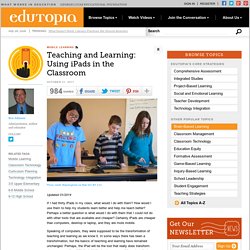
How would I use them to help my students learn better and help me teach better? Perhaps a better question is what would I do with them that I could not do with other tools that are available and cheaper? Certainly iPads are cheaper than computers, desktop or laptop, and they are more mobile. Speaking of computers, they were supposed to be the transformation of teaching and learning as we know it. Kinesthetic Learners The iPad has a number of unique features that provide for interesting possibilities in teaching and learning. Using Prezi In Education. On the educational scene, Prezi is fast becoming the new kid on the block.
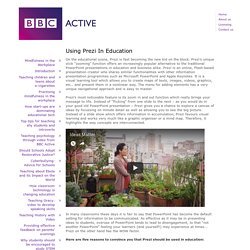
Prezi’s unique slick “zooming” function offers an increasingly popular alternative to the traditional PowerPoint presentations in education and business alike. Prezi is an online, Flash-based presentation creator who shares similar functionalities with other information presentation programmes such as Microsoft PowerPoint and Apple Keynotes. It is a visual learning tool which allows you to create maps of texts, images, videos, graphics, etc… and present them in a nonlinear way.
10 Things Teachers Should Know To Do With Google Docs. Google Docs is a powerful word processing tool that many schools have adopted.
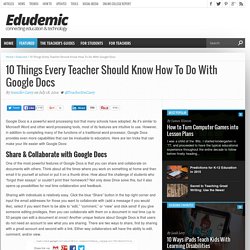
As it’s similar to Microsoft Word and other word processing tools, most of its features are intuitive to use. However, in addition to completing many of the functions of a traditional word processor, Google Docs provides even more capabilities that can be invaluable to educators. Here are ten tricks that can make your life easier with Google Docs: Share & Collaborate with Google Docs One of the most powerful features of Google Docs is that you can share and collaborate on documents with others. How to Integrate Technology. When technology integration in the classroom is seamless and thoughtful, students not only become more engaged, they begin to take more control over their own learning, too.
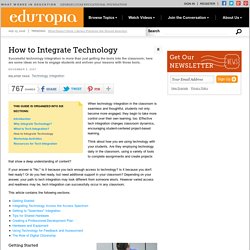
Effective tech integration changes classroom dynamics, encouraging student-centered project-based learning. Think about how you are using technology with your students. Are they employing technology daily in the classroom, using a variety of tools to complete assignments and create projects that show a deep understanding of content? If your answer is "No," is it because you lack enough access to technology? Is it because you don't feel ready? This article contains the following sections: 10 Ways to Use Technology to Build Vocabulary.
Click the "References" link above to hide these references.

Adesope, O.O., Lavin, T., Thompson, T., & Ungerleider, C. (2010). A systematic review and meta-analysis of the cognitive correlates of bilingualism. Review of Educational Research, 80(2), 207-245. doi:10.3102/0034654310368803. 6 Easy Steps for Getting Started Using Free Plickers for Assessment. Data is an essential component in education, yet sometimes it can be viewed as a necessary evil for educators.
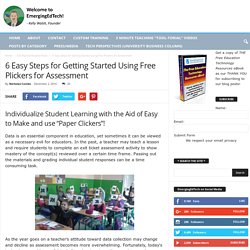
In the past, a teacher may teach a lesson and require students to complete an exit ticket assessment activity to show mastery of the concept(s) reviewed over a certain time frame. Passing out the materials and grading individual student responses can be a time consuming task. Education videos: Ten ways to use them well. Why use video resources?
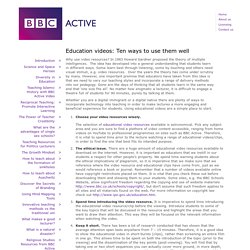
In 1983 Howard Gardner proposed the theory of multiple intelligences. The idea has developed into a general understanding that students learn in different ways. Some learn best through listening; some by touching and others need visual stimuli, e.g. video resources. Over the years the theory has come under scrutiny by many. Quick start guide to flipping your classroom using screencasting or lecture videos – Turn to Your Neighbor: The Official Peer Instruction Blog. On Your Mark, Get Set, FLIP!

Are you thinking about flipping your classroom? There are lots of different, interesting ways to flip a class. One popular, entry-level approach to flipped teaching is to deliver direct instruction (i.e. lectures) outside of class, using pre-recorded videos covering content. Instructors then spend class time on activities that students would normally do at home, such as homework problems. Flipped experts Bergmann and Sams call this the “flipped 101” approach, emphasizing that there is more than one way to flip a class and putting videos online and doing homework in class is one of the most basic of those ways. For videos in a flipped 101 approach, some instructors select pre-existing content that others have created to use as direct instruction. Ready? Keep these prep steps in mind as you get ready to flip your classroom. Quick Start Guide (Download a PDF of the guide here) Podcasting In and Out of the Classroom. A podcast is an audio story created to share ideas, presentations, or music.

Typically podcasts are linked from a blog, so "podcasting" is often used to denote audioblogging. Students can use podcasts in the classroom to interview each other, tell stories, create newscasts, hold debates, or run radio shows. Schools can use podcasts to make announcements via their Web site or to record guest speakers and publish their presentations available online. In podcasting, the producer records the audio, edits it, and then distributes it via the web. Podcasts sometimes resemble radio programs as some podcasters add music and various sound effects to their recorded audio.
The podcast file type is very important. Visit our audio recording and editing apps page for a complete list of tools that work on any device.